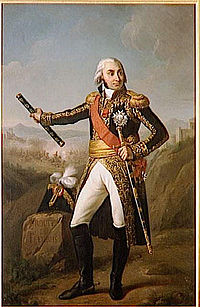- Baton (symbol)
-
For other uses, see Baton.
The ceremonial baton is a short, thick stick, carried by select high-ranking military officers as a uniform article. The baton is distinguished from the swagger stick in being thicker and less functional (not used as a crop). Unlike a staff of office, a baton is not rested on the ground. Unlike a royal sceptre, a baton is typically flat-ended, not crowned on one end with an eagle or globe.
Contents
Classical era
The origin of the command baton is remote but common to all pastoral societies and the ones in Egypt and Rome are manifest through art. In western Europe most are later variations of the ones consuls received and that represented the over all command of those tied to the fasces that represented the Roman tribes that composed the Roman people. With time they came to be extended to the commanders that held the supreme authority, civilian and military over the provinces of the Republic, and later under the dictatorships and finally the Emperor.
A short, heavy, white baton was the symbol of the imperial mandate given to a Roman military legate. He held it high proclaiming "above your head and mine" to represent the Emperor.
It is possible that the Spartan cipher rod, Scytale, also had a related military status, pre-dating the Roman baton, but the first detailed reference in Plutarch dates from the Roman period.
Napoleonic era
Aping the Romans, the French kings and then Napoleon, provided their marshals with ornate batons, sewn with stars or bees, respectively. Other armies copied the practice for their marshals. The Duke of Wellington was awarded marshal's batons by 12[dubious ] different countries;[1] 10 are now displayed at his home, Apsley House.[2] The Russian baton was stolen on 9 December 1965 and has not been recovered.[3]
Third Reich

During the Third Reich, marshals and grand admirals carried ceremonial batons, specially manufactured by German jewelers. Seven styles of batons were awarded to 25 individuals. Hermann Göring earned two different-style batons for his Field Marshal and Reich Marshal promotions.
All the batons, except Raeder's, were of similar construction: a shaft decorated with Iron Crosses and Wehrmacht eagles. Air Force (Luftwaffe) shafts added Balkan crosses, while Navy (Kriegsmarine) shafts added fouled anchors. Ends of the batons had ornate caps.
- The seven styles of Third Reich batons
- The first baton awarded was to Army Field Marshal Werner von Blomberg. This baton's shaft had a light blue velvet covering material. It is now in the National Museum of American History in Washington, DC.
- The first Air Force baton awarded was to Hermann Göring after his promotion to field marshal. While of similar construction to the Blomberg baton (with light blue velvet shaft covering), it incorporated the Balkan cross Air Force symbols. Additionally, the endcaps were inlaid with many small diamonds. It is now in the National Infantry Museum, Fort Benning, Columbus, Georgia.
- The next baton awarded was to Grand Admiral Eric Raeder. This baton's shaft had a dark blue velvet covering. This baton differed from other Third Reich batons by having a chainlink pattern sewed over the crosses, eagles and anchors. At war end, the baton was reportedly disassembled and sold in pieces.
- Nine Army batons were awarded in the summer of 1940 to newly promoted field marshals. The batons' shafts had red velvet coverings and differed only in identifiying enscriptions on the endcaps. Eight more batons of this style were later awarded to other field marshals upon their promotions. The first group was manufactured for 6,000 marks (about 15,000 USD in 2008) each. Most of the batons are now in museums or private collections.
- Three Air Force batons were awarded in the summer of 1940. They had blue velvet covering and Balkan crosses, differing only in individual endcap enscriptions. One more baton of this style was awarded in 1943. The 1940 Air Force batons were slightly more expensive to manufacture than the 1940 Army batons.
- The only other Navy baton was awarded to Grand Admiral Karl Dönitz. It had a blue velvet shaft covering and incorporated a U-Boat symbol on one of the endcaps. It is now in the Shropshire Regimental Museum, Shrewsbury, UK, and was donated by Major General J. B. Churches, who captured Dönitz at war's end.
- The only reich marshal baton was presented to Hermann Göring in 1940. While similar looking to the other 1940 batons, it incorporated exceptional materials. The shaft was white elephant ivory, not velvet-covered metal. The endcaps incorporated platinum in the inscription banding and over 600 small diamonds. The baton was manufactured for 22,750 marks (about 55,000 USD in 2008). It is now in the US Army's West Point Museum, Highland Falls, NY.
Modern
The traditional baton of the Aymara Indians featured in an alternative inauguration ceremony for the first Indio president of Bolivia in January 2006.
See also
References
- ^ "Batons [of] the Late Duke of Wellington". The Illustrated London News No. 532. 11 December 1852. http://www.victorianweb.org/periodicals/iln/20g.html. Retrieved 8 June 2011.
- ^ "Duke of Wellington's batons". English Heritage. http://www.englishheritageimages.com/low.php?xp=media&xm=4513845. Retrieved 8 June 2011.
- ^ "2 Robbers Beat Guard, Steal Priceless Jewels". The Spokesman-Review. 10 December 1965. http://news.google.co.uk/newspapers?id=yLRWAAAAIBAJ&sjid=0ugDAAAAIBAJ&pg=6178,2772911&dq=apsley+house+1965+stolen&hl=en.
- Larousse, undated (early 20th century)
- The Rise and Fall of the Third Reich, William L. Shirer (several notes of field marshals carrying batons, but not details on construction)
External links
Categories:- Ceremonial weapons
- Formal insignia
Wikimedia Foundation. 2010.


